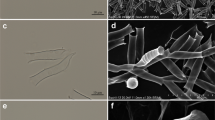Abstract
THE taxonomy of Coccolithophoridaceæ is based upon the morphology of the coccoliths. On account of the minute size of most of the coccoliths it has not been possible to obtain satisfactory pictures of them, even with the best optical equipment. This has caused confusion in the classification of coccolithophorids. It is illustrative that the most abundant and common species, Pontosphæra huxleyi Lohm., has been shown to include three taxonomical units with different coccoliths1. One is referred to the new genus Gephyrocapsa Kamptner, the others to Coccolithus Schwartz.
This is a preview of subscription content, access via your institution
Access options
Subscribe to this journal
Receive 51 print issues and online access
$199.00 per year
only $3.90 per issue
Buy this article
- Purchase on Springer Link
- Instant access to full article PDF
Prices may be subject to local taxes which are calculated during checkout
Similar content being viewed by others
References
Kamptner, E., “Zur Revision der Coccolithineen-Spezies Pontosphæra huxleyi Lohm.”, Akademische Anzeiger, No. 11 (1943).
Author information
Authors and Affiliations
Rights and permissions
About this article
Cite this article
BRAARUD, T., NORDLI, E. Coccoliths of Coccolithus huxleyi seen in an Electron Microscope. Nature 170, 361–362 (1952). https://doi.org/10.1038/170361a0
Issue Date:
DOI: https://doi.org/10.1038/170361a0
This article is cited by
-
Crystallographic analysis of the coccolith ofCoccolithus huxleyi
Calcified Tissue Research (1967)
-
Elektronenmikroskopische Untersuchungen an Bianconekalken des Südtessins
Experientia (1956)
Comments
By submitting a comment you agree to abide by our Terms and Community Guidelines. If you find something abusive or that does not comply with our terms or guidelines please flag it as inappropriate.



